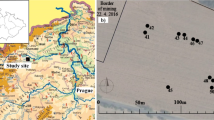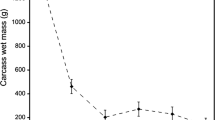Abstract
In-soil human decomposition is comprehensively described in terms of the physico-chemical and bacterial environmental conditions. Much of the understanding comes from considerations of cemetery studies and experimentation with adipocere. The understandings are relevant for further studies in cemetery management, exhumations, forensic investigations and anthropology. In the soil, cadavers are subject to various sets of decomposition processes principally resulting from aerobic (usually the initial) or anaerobic (usually the sustaining) conditions. The presence of percolating groundwater and microorganisms further affects the rate of breakdown and fate of the products. The major human tissue components—protein, carbohydrate, fat and bone, are discussed; and the likely pathways of decomposition products enumerated. The effects of liquefaction, availability of oxygen and other in-grave processes are considered.





Similar content being viewed by others
References
Alexander M (1999) Biodegradation and bioremediation, 2nd edn. Academic Press, San Diego, 424 pp
Bethell PH, Carver MOH (1987) Detection and enhancement of decayed inhumations at Sutton Hoo. In: Boddington A, Garland AN, Janaway RC (eds) Death, decay and reconstruction: approaches to archaeology and forensic science. Manchester University Press, Manchester, pp 10–21
Bolt GH, Bruggenwert MGM (1978) Soil chemistry: developments in soil science, 2nd edn. Elsevier, Amsterdam
Bouwer H, Chaney RL (1974) Land treatment of wastewater. Adv Agron 26:133–176
Cabriol N, Pommier MT, Gueux M, Payen G (1998) Comparison of lipid composition in two types of human putrefactive liquid. Forensic Sci Int 94:47–54
Clark MA, Worrell MB, Pless JE (1997) Postmortem changes in soft tissues. In: Haglund WD, Sorg MH (eds) Forensic taphonomy. CRC Press, Boca Raton, pp 151–164
Cook SF, Heizer RF (1965) Studies on the chemical analysis of archaeological sites. Univ California Press, Berkeley, 120 pp
Corry JEL (1978) A review. Possible sources of ethanol ante- and post-mortem: its relationship to the biochemistry and microbiology of decomposition. J Applied Bacteriol 44:1–56
Dent BB (1995) Hydrogeological studies at Botany Cemetery, New South Wales. MSc Project Report, University of Technology, Sydney (unpub)
Dent BB (2002) The hydrogeological context of cemetery operations and planning in Australia. PhD Thesis, University of Technology, Sydney (unpub)
Dent BB, Knight MJ (1998) Cemeteries: a special kind of landfill. The context of their sustainable management. In: Weaver TR, Lawrence CR (eds) Proc Int Groundwater Conf, 8–13th February, Melbourne. International Association of Hydrogeologists (Australian National Chapter), Indooroopilly, Australia, pp 451–456
Domenico PA, Schwartz FW (1990) Physical and chemical hydrogeology. Wiley, New York, 528 pp
Evans WED (1963) The chemistry of death. Thomas, Springfield, 101 pp
Folsom BL, Wagner GH, Scrivener CL (1974) Comparison of soil carbohydrates in several prairie and forest soils by gas-liquid chromatography. Proc Soil Sci Soc Amer 38:305–309
Forbes SL (2003) An investigation of the factors affecting the formation of adipocere in grave soils. PhD Thesis, University of Technology, Sydney (unpub)
Forbes SL, Stuart BH, Dent BB (2002) The identification of adipocere in grave soils, Forensic Sci Int 127:225–230
Forbes SL, Stuart BH, Dadour I, Dent BB (2003) A quantitative investigation of pig adipocere. J Forensic Sci (in press)
Galloway A (1997) The process of decomposition: a model from the Arizona-Sonoran Desert. In: Haglund WD, Sorg MH (eds) Forensic taphonomy. CRC Press, Boca Raton, pp 139–150
Gill-King H (1999) Chemical and ultrastructural aspects of decomposition. In: Haglund WD, Sorg MH (eds) Forensic taphonomy. CRC Press, Boca Raton, pp 93–108
Goffer Z (1980) Archaeological chemistry: a sourcebook on the applications of chemistry to archaeology. Wiley, New York, 208 pp
Gray TRG, Williams ST (1971) Soil micro-organisms. Oliver and Boyd, Edinburgh
Haagsma J (1991) Pathogenic anaerobic bacteria and the environment. Rev Sci Tech Off Int Epiz 10(3):749–764
Hare PE (1976) Organic geochemistry of bone and its relation to the survival of bone in the natural environment. In: Behrensmeyer AK, Hill AP (eds) Fossils in the making: vertebrate taphonomy and paleoecology. University of Chicago Press, Chicago, pp 208–219
Hart H, Schuetz RD (1966) Organic chemistry, 3rd edn. Houghton Mifflin, Boston
Hem JD (1989) Study and interpretation of the chemical characteristics of natural water. US Geol Surv Water-Supply Paper 2254
Henderson J (1987) Factors determining the preservation of human remains. In: Boddington A, Garland AN, Janaway RC (eds) Death, decay and reconstruction: approaches to archaeology and forensic science. Manchester University Press, Manchester, pp 43–54
Higgins IJ, Burns RG (1975) The chemistry and microbiology of pollution. Academic Press, London
Janaway RC (1993) The textiles. In: The Spitalfields project 1: The archaeology, across the Styx. Council for British Archaeology
Janaway RC (1997) The decay of buried human remains and their associated materials. In: Hunter J, Roberts C, Martin A (eds) Studies in crime: an introduction to forensic archaeology. Routledge, London, pp 58–85
Janssen W (1984) Forensic histopathology. Springer, Berlin Heidelberg New York, 402 pp
Killman K (1994) Soil ecology. Cambridge University Press, Cambridge, 260 pp
Knight MJ, Dent BB (1995) A watery grave—the role of hydrogeology in cemetery practice. ACCA News (Summer):19–22
Knight MJ, Dent BB (1998) Sustainability of waste and groundwater management systems. In: Weaver TR, Lawrence CR (eds) Proc Int Groundwater Conf, 8–13th February, Melbourne. International Association of Hydrogeologists (Australian National Chapter), Indooroopilly, Australia, pp 359–374
Lewis W (1851) On the chemical and general effects of the practice of interment in vaults and catacombs. Lancet 2:125–126
Lewis-Jones R, Winkler M (1991) Sludge parasites and other pathogens. Ellis Horwood, New York, 240 pp
Mann RW, Bass WM, Meadows L (1989) Time since death and decomposition of the human body: variables and observations in case and experimental field studies. J Forensic Sci 35(1):103–111
Mant AK (1957) Adipocere – a review. J Forensic Medicine 4(1):18–35
Mant AK (1987) Knowledge acquired from post-War exhumations. In: Boddington A, Garland AN, Janaway RC (eds) Death, decay and reconstruction: approaches to archaeology and forensic science. Manchester University Press, Manchester, pp 65–78
Martins MT, Pellizari VH, Pacheco A, Myaki DM, Adams C, Bollolan CA, Mendes JMB, Hassuda S (1991) Qualidade bacteriológica de águes subterrâneas em cemitérios (Bacteriological quality of underground waters in cemeteries). Rev Saúde públ 25(1):47–52 (in Portuguese)
Owsley DW, Compton BE (1997) Preservation in late 19th century iron coffin burials. In: Haglund WD, Sorg MH (eds) Forensic taphonomy. CRC Press, Boca Raton, pp 511–526
Polson CJ, Gee DJ, Knight B (1985) The essentials of forensic medicine, 4th edn. Pergamon Press, Oxford
Reimann C, de Caritat P (1998) Chemical elements in the environment: Factsheets for the geochemist and environmental scientist. Springer, Berlin Heidelberg New York, 397 pp
Reynold AE, Cahill GF (1965) Handbook of physiology: Adipose tissue. American Physiological Society, Washington
Santarsiero A, Minelli L, Cutilli D, Cappiello G (2000) Hygienic aspects related to burial. Microchemical J 67(1–3):135–139
Santoro T, Stotzky G (1968) Sorption between microorganisms and clay minerals as determined by the electrical sensing zone particle analyzer. CanJ Microbiol 14:299–307
Spennemann DHR, Franke B (1994) On the dark stains observed in some Tongan burials. Archaeology New Zeal 37(1):35–43
van Haaren FWJ (1951) Churchyards as sources for water pollution. Moorman’s Periodieke Pers 35(16):167–172 (in Dutch)
Waksman SA, Starkey RL (1931) The soil and the microbe. Wiley, New York, 73 pp
Whitelaw K, Edwards RA (1980) Carbohydrates in the unsaturated zone of the chalk, England. Chem Geol 29(3–4):281–291
Wilkins R (1992) The fireside book of death. Warner Books, London
WHO (World Health Organisation) (1993) Guidelines for drinking-water quality, vol 1 recommendations, 2nd edn. World Health Organisation, Geneva
Author information
Authors and Affiliations
Corresponding author
Rights and permissions
About this article
Cite this article
Dent, B.B., Forbes, S.L. & Stuart, B.H. Review of human decomposition processes in soil. Env Geol 45, 576–585 (2004). https://doi.org/10.1007/s00254-003-0913-z
Received:
Accepted:
Published:
Issue Date:
DOI: https://doi.org/10.1007/s00254-003-0913-z




